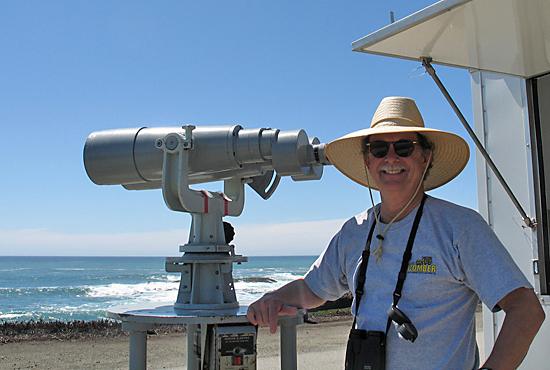Gray
Whales: Weathering Change?
With Comments
from Wayne Perryman, Biologist
 |
| Wayne Perryman is the government's leading expert on gray whale cows and calves. He counts them each spring as they pass the California coast at Pt. Piedras Blancas on their way to Alaska. |
A
Changing Environment
Mr.
Perryman reminds us, “Most of the eastern Pacific population
of gray whales feeds in the Arctic during the summer to early fall.
That environment has changed significantly over the past 15 years.
As the climate warms, ice gets thinner and it covers less area. This
change impacts a wide range of marine mammals (seals, walrus, whales,
polar
bears).
Right
now, we can feel comfortable saying that gray whales are feeding
in different places (farther north) and on different prey than they
did
back in the 1980s."
Changes
in Feeding Areas
Before
leaving their arctic homes and migrating south to Baja Mexico,
gray whales feast on tiny crustaceans
that live on the
ocean
floor.
This
is how whales put on thick layers of blubber to help sustain
them during their migration south, the winter in Mexico's lagoons, and
the return migration north.
As warmer
waters melt the sea ice, other animals move into the whales'
feeding grounds. Crowded by the new competition for food, gray whales then must
travel further north and feed longer to
get filled up and gain blubber.
Changes in Migration Timing
Changes in the Arctic, say scientists, have disrupted
the timing
of the whales'
yearly
migration.
Whale
watchers and marine scientists note that gray whales have been
delaying their southward migrations as they stay longer to eat. For
example, compared to two decades ago, gray whales are reaching the
Monterey
Bay area
a week
or more
later. "This isn't trivial," says Mr. Perryman. "It's
a significant change."
"It takes a long-time series of data to know how this is affecting the whale population. Climate changes slowly in the long term while weather can fluctuate widely in the sort term, so it takes time to tease out the long-term effects from the short-term ones.
Changes in Population Growth
"It
appears that growth of the gray whale population has slowed and may
have stopped. Also, reproduction (indicated by number of calves migrating
north) has fluctuated widely, and in general has been lower than
we would expect for a growing population. How this all fits into
the puzzle
of climate change effects is a good question. Perhaps YOU will become
a scientist and help to figure it out!"
Try This! Journal Questions
- Read more about Mr. Perryman here. Think about how his life prepared him for the job he has today. What things do YOU enjoy doing that might lead to enjoyable work in your future?
- What would be some consequences for the gray whale food supply if arctic ice continues to melt later and to cover less area?
- How might changes in the whales' migration schedule affect these mammals in the future?
- Of the challenges you know about today, which do you think are most important for scientists to be studying? Explain.
- Find out more about gray whales and list factors that might make the species' population decrease.


